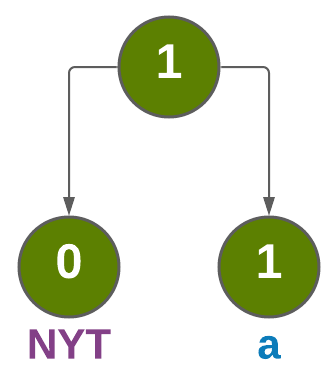Decision Tree Algorithm
Decision tree learning or induction of decision trees is one of the predictive modelling approaches used in statistics, data mining and machine learning. It uses a decision tree (as a predictive model) to go from observations about an item (represented in the branches) to conclusions about the item’s target value (represented in the leaves).
import matplotlib.pyplot as plt
import itertools
import pandas as pd
from pandas.plotting import radviz
import numpy as np
import sys
vectors_set = pd.read_table('vectors.txt',header=None, index_col=False, delimiter=r"\s+")
Node Class Object
- The constructor gets the tree’s level where the node is located.
- coordinate used only for inner nodes
- ones and zeros are counting each vector’s label to this node.
- For leaves:
- classifyVector it gets the label of the vector and counts the relevant.
- getSymbol returns the symbol of the leaf (the most common label).
- getError returns the error which is the less voted label between the two.
class Node:
def __init__(self, level):
self.level = level
self.coordinate = -1
self.left = None
self.right = None
self.vectors = []
self.leaf = False
self.error = 0
self.coordinates_path = []
self.ones = 0
self.zeros = 0
self.symbol = -1
def classifyVector(self, vector_label):
if vector_label == 0:
self.zeros += 1
else:
self.ones += 1
def getSymbol(self):
if self.zeros > self.ones:
return 0
else:
return 1
def getError(self):
return min([self.ones,self.zeros])
def setLeftChild(self, new_left):
self.left = new_left
def setRightChild(self, new_right):
self.right = new_right
def getCoordinate(self):
return self.coordinate
def setCoordinate(self, co):
self.coordinate = co
DecisionTree Class Object
- The constructor:
- Gets the max level of the tree (k) and the coordinates.
- Create a root and set the first coordinate to it.
- Counts the number of nodes and holds the leaves while building.
- Generate the tree by the given new root.
- generateTree class:
- At the first step it gets the root and starts to build the tree.
- If the node’s level equals to k it means that it reached to the max level - it will be a leaf.
- Creates left and right child and sets the coordinates for each one of them by the use of node number (only for inner nodes)
- Goes recursivly till it reached to a leaf.
- getError gets the errors just after we are using the Algorithm class, we divide by 150 which is the number of total vectors.
class DecisionTree:
def __init__(self, k):
self.k = k
self.root = Node(1)
self.root.vectors = vectors_set.index
self.coordinates = []
self.leaves = []
self.error = 0
def generateResults(self):
self.getNodes(self.root)
self.error = self.root.error/150
def getNodes(self, node):
if node != None:
if node.left == None and node.right == None:
self.leaves.append(node)
return
else:
self.coordinates.append(node.coordinate)
self.getNodes(node.left)
self.getNodes(node.right)
def getError(self):
return self.error
BruteForceAlgorithm Class
- The construcor:
- Gets the k which is the max level.
- Creates all permutations of coordinates set size by k filling with numbers between 0-7.
- Loads the data (vectors)
- Keeps the best tree at the end of the algorithm
- start method:
- Will find the tree with the minimal errors from all the given permutations
- for each tree, which will be generated automatically in the DecisionTree constructor, it will use the runTree method which returns the error of the tree and decides if it has a lower error than all previous ones.
- runTree method:
- for each vector (150) it traverse and fills the leaves with labels.
- then we sum all of the errors of the leaves in the tree and return the errror.
- traverseVector method:
- Gets vector and a node.
- Traverse the tree by the coordinates of the vector which is given from the current node at each step.
- Till it reach to a node and then add the vector’s label to the “vote” of the leaf.
class BruteForceAlgorithm:
def __init__(self, k, vectors):
self.k = k
self.vectors_set = vectors
def getTree(self):
tree = DecisionTree(self.k)
self.run(tree.root)
tree.generateResults()
return tree
def run(self, node):
if node.level == self.k:
for vector in node.vectors:
node.classifyVector(self.vectors_set.iloc[vector][8])
node.error = node.getError()
node.symbol = node.getSymbol()
return
best_coordinate = -1
min_error = sys.maxsize
for coordinate in range(8):
if coordinate not in node.coordinates_path:
node.coordinate = coordinate
left = Node(node.level + 1)
right = Node(node.level + 1)
for vector in node.vectors:
value = self.vectors_set.iloc[vector][coordinate]
if value == 0:
left.vectors.append(vector)
else:
right.vectors.append(vector)
left.coordinates_path.extend(node.coordinates_path)
right.coordinates_path.extend(node.coordinates_path)
left.coordinates_path.append(coordinate)
right.coordinates_path.append(coordinate)
self.run(left)
self.run(right)
error = left.error + right.error
if error < min_error:
min_error = error
if left.error != 0:
node.left = left
if right.error != 0:
node.right = right
best_coordinate = coordinate
node.coordinate = best_coordinate
node.coordinates_path.append(best_coordinate)
node.error = min_error
BinaryEntropy Class
class BinaryEntropy:
def __init__(self, k, vectors):
self.k = k
self.vectors_set = vectors
self.best_tree = None
self.leaves = []
self.errors = 0
self.root = Node(1)
self.root.vectors = vectors.index
self.coordinates = []
def start(self):
self.getTree(self.root)
return self.root
def getTree(self, node):
if node != None:
if node.level == self.k or (node != self.root and (node.ones == 0 or node.zeros == 0)):
node.leaf = True
self.leaves.append(node)
node.symbol = node.getSymbol()
return
left_child = None
right_child = None
min_error = sys.maxsize
best_coordinate = -1
for coordinate in range(8):
if coordinate not in node.coordinates_path:
temp_left = Node(node.level+1)
temp_right = Node(node.level+1)
for index in node.vectors:
value = self.vectors_set.iloc[index][coordinate]
label = self.vectors_set.iloc[index][8]
if value == 0:
temp_left.classifyVector(label)
temp_left.vectors.append(index)
else:
temp_right.classifyVector(label)
temp_right.vectors.append(index)
error = sys.maxsize
if len(temp_left.vectors) != 0 and len(temp_right.vectors) != 0:
error = self.getEntropyError(temp_left, temp_right)
if error < min_error and coordinate not in node.coordinates_path:
min_error = error
best_coordinate = coordinate
left_child = temp_left
right_child = temp_right
if best_coordinate == -1:
node.leaf = True
self.leaves.append(node)
node.symbol = node.getSymbol()
else:
node.setCoordinate(best_coordinate)
node.coordinates_path.append(best_coordinate)
self.coordinates.append(best_coordinate)
if left_child != None:
left_child.coordinates_path.extend(node.coordinates_path)
node.setLeftChild(left_child)
if right_child != None:
right_child.coordinates_path.extend(node.coordinates_path)
node.setRightChild(right_child)
self.getTree(left_child)
self.getTree(right_child)
def getEntropyError(self, left, right):
left_total = left.ones + left.zeros
left_wrong = left.getError()
left_err = left_wrong/left_total
left_entropy = 101
if left_wrong == 0: ## if all vectors are fitting
left_entropy = 0
if left_total == 0: # if no vector reached to this node
left_entropy = 1
if left_wrong != 0 and left_total != 0:
left_entropy = -left_err*np.log2(left_err) - (1-left_err)*np.log2(1-left_err)
right_total = right.ones + right.zeros
right_wrong = right.getError()
right_err = right_wrong/right_total
right_entropy = 101
if right_wrong == 0: ## if all vectors are fitting
right_entropy = 0
if right_total == 0: # if no vector reached to this node
right_entropy = 1
if right_wrong != 0 and right_total != 0:
right_entropy = -right_err*np.log2(right_err) - (1-right_err)*np.log2(1-right_err)
return left_entropy + right_entropy
def runTree(self, tree):
for leave in self.leaves:
leave.ones = 0
leave.zeros = 0
for vector in range(len(self.vectors_set[0].values)):
self.traverseVector(tree, vector)
self.errors = 0
for leave in self.leaves:
self.errors += leave.getError()
return self.errors / 150
def traverseVector(self, node, vector):
if node.leaf:
label = self.vectors_set.iloc[vector][8]
node.classifyVector(label)
return
else:
node_coordinate = node.getCoordinate()
if node_coordinate >= 0:
coo = self.vectors_set.iloc[vector][node_coordinate]
if coo == 0 :
self.traverseVector(node.left, vector)
elif coo == 1:
self.traverseVector(node.right, vector)
Print tree method
def print_tree(root, coordinate="coordinate", symbol="symbol", left="left", right="right"):
def display(root, coordinate=coordinate, symbol=symbol, left=left, right=right):
"""Returns list of strings, width, height, and horizontal coordinate of the root."""
# No child.
if getattr(root, right) is None and getattr(root, left) is None:
line = '%s' % getattr(root, symbol)
width = len(line)
height = 1
middle = width // 2
return [line], width, height, middle
# Only left child.
if getattr(root, right) is None:
lines, n, p, x = display(getattr(root, left))
s = '%s' % getattr(root, coordinate)
u = len(s)
first_line = (x + 1) * ' ' + (n - x - 1) * '_' + s
second_line = x * ' ' + '/' + (n - x - 1 + u) * ' '
shifted_lines = [line + u * ' ' for line in lines]
return [first_line, second_line] + shifted_lines, n + u, p + 2, n + u // 2
# Only right child.
if getattr(root, left) is None:
lines, n, p, x = display(getattr(root, right))
s = '%s' % getattr(root, coordinate)
u = len(s)
first_line = s + x * '_' + (n - x) * ' '
second_line = (u + x) * ' ' + '\\' + (n - x - 1) * ' '
shifted_lines = [u * ' ' + line for line in lines]
return [first_line, second_line] + shifted_lines, n + u, p + 2, u // 2
# Two children.
left, n, p, x = display(getattr(root, left))
right, m, q, y = display(getattr(root, right))
s = '%s' % getattr(root, coordinate)
u = len(s)
first_line = (x + 1) * ' ' + (n - x - 1) * '_' + s + y * '_' + (m - y) * ' '
second_line = x * ' ' + '/' + (n - x - 1 + u + y) * ' ' + '\\' + (m - y - 1) * ' '
if p < q:
left += [n * ' '] * (q - p)
elif q < p:
right += [m * ' '] * (p - q)
zipped_lines = zip(left, right)
lines = [first_line, second_line] + [a + u * ' ' + b for a, b in zipped_lines]
return lines, n + m + u, max(p, q) + 2, n + u // 2
lines, *_ = display(root, coordinate, symbol, left, right)
for line in lines:
print(line)
print()
Testing mode
def printBruteForceScenarios():
print("BRUTE FORCE TESTING IN RANGE 2<=K<=7")
for k in range(2,8):
bfAlgorithm = BruteForceAlgorithm(k, vectors_set)
bftree = bfAlgorithm.getTree()
print(f'==> k={k} , minimal error: {bftree.getError()}')
print("==========================================")
def printBinaryEntropyScenarios():
print("BINARY ENTROPY TESTING IN RANGE 2<=K<=9")
for k in range(2,10):
beAlgorithm = BinaryEntropy(k, vectors_set)
beTree = beAlgorithm.start()
errors_entropy = beAlgorithm.runTree(beTree)
print(f'==> k={k} , minimal error: {errors_entropy}')
print("==========================================")
# printBruteForceScenarios()
# printBinaryEntropyScenarios()
Tested Scenarios
BRUTE FORCE TESTING IN RANGE 2<=K<=7
==> k=2 , minimal error: 0.44
==> k=3 , minimal error: 0.38
==> k=4 , minimal error: 0.34
==> k=5 , minimal error: 0.2733333333333333
==> k=6 , minimal error: 0.19333333333333333
==> k=7 , minimal error: 0.14666666666666667
==========================================
BINARY ENTROPY TESTING IN RANGE 2<=K<=9
==> k=2 , minimal error: 0.44
==> k=3 , minimal error: 0.4266666666666667
==> k=4 , minimal error: 0.3933333333333333
==> k=5 , minimal error: 0.3333333333333333
==> k=6 , minimal error: 0.29333333333333333
==> k=7 , minimal error: 0.21333333333333335
==> k=8 , minimal error: 0.17333333333333334
==> k=9 , minimal error: 0.14666666666666667
==========================================
bf_scenarios = [0.44, 0.38, 0.34, 0.2733333333333333, 0.19333333333333333, 0.14666666666666667]
entropy_scenarios = [0.44, 0.4266666666666667, 0.3933333333333333, 0.3333333333333333, 0.29333333333333333, 0.21333333333333335]
scenarios = [2,3,4,5,6,7]
plt.plot(scenarios, entropy_scenarios, label='Binary Entropy')
plt.plot(scenarios, bf_scenarios, label='Brute Force')
plt.legend()
plt.xlabel('k levels')
plt.ylabel('Error')
plt.title("Binary Entropy VS Brute Force")
plt.show()

Run the algorithms and show final results (K=3)
bfAlgorithm = BruteForceAlgorithm(3, vectors_set)
bftree = bfAlgorithm.getTree()
print(f'Minimal errors: {bftree.getError()}')
print(bftree.coordinates)
print()
print_tree(bftree.root)
beAlgorithm = BinaryEntropy(3, vectors_set)
beTree = beAlgorithm.start()
errors_entropy = beAlgorithm.runTree(beTree)
print(f'Minimal errors: {errors_entropy}')
print(beAlgorithm.coordinates)
print()
print_tree(beTree)
Minimal errors: 0.38
[4, 1, 0]
_4_
/ \
1 0
/ \ / \
0 1 1 0
Minimal errors: 0.4266666666666667
[3, 0, 1]
_3_
/ \
0 1
/ \ / \
1 0 1 1






Leave a comment